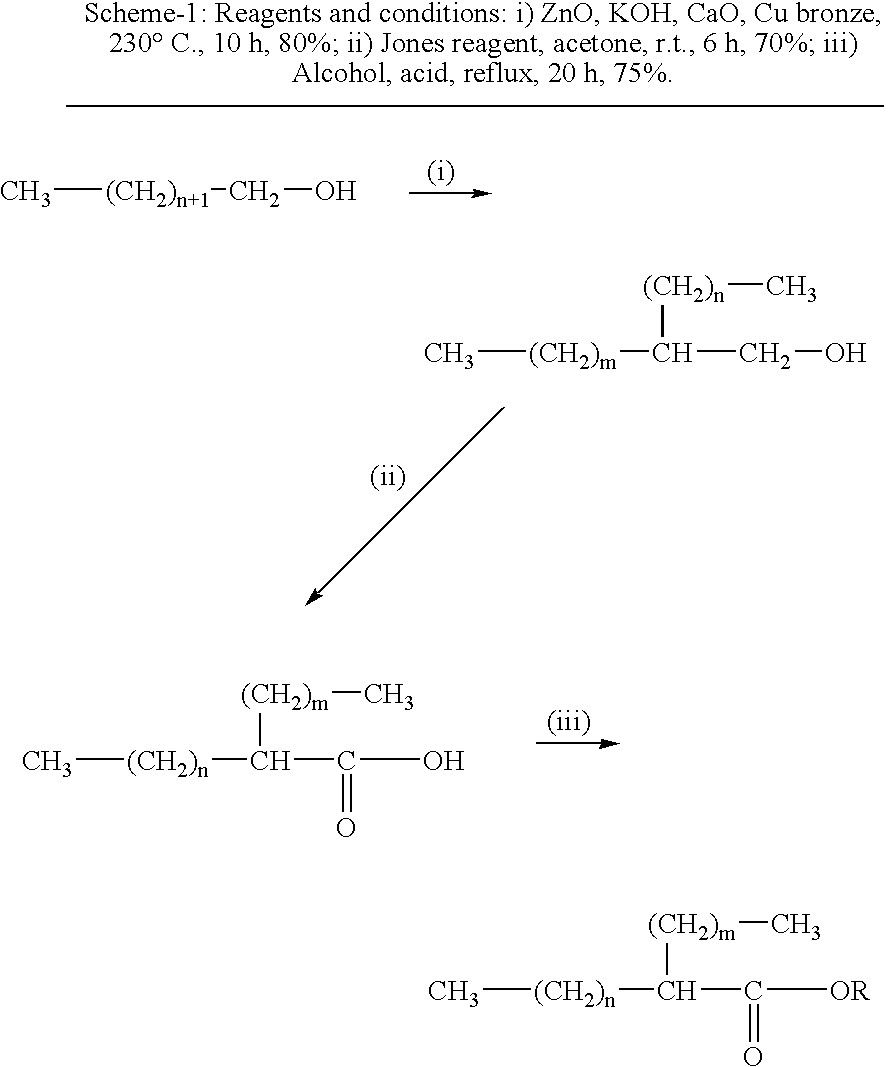Novel synthetic fuel and method of preparation thereof
a synthetic fuel and fuel technology, applied in the field of fuels, can solve the problems of serious scientific challenge in the preparation of upgraded synthetic diesel fuels, and achieve the effects of improving diesel fuel properties, excellent low temperature properties and oxidative stability
- Summary
- Abstract
- Description
- Claims
- Application Information
AI Technical Summary
Benefits of technology
Problems solved by technology
Method used
Image
Examples
example 1
[0048]The synthetic fuel was prepared by using a 1000 ml glass reactor, provided with thermostat, mechanical stirring, sampling outlet, and condensation system. Octanol-1 (300 g) was charged to the reactor and ZnO (2 g), KOH (6 g), CaO (5 g) and Cu Bronze (1.5 g) were added. The above reaction mixture was heated at 200° C. for 8 hours to complete the reaction. The reaction mixture was filtered and purified by distillation to get 2-hexyl-1-decanol (250 g). 2-Hexyl-1-decanol (250 g) was reacted with Jones reagent (200 ml) in acetone (200 ml) to get 2-hexyl-1-decanoic acid. 2-Hexyl-1-decanoic acid produced (200 g) was again charged to the above reactor and subsequently, methanol (200 g) and sulfuric acid (6.0 g) were added slowly to the reactor with stirring. The reaction mixture was refluxed till completion of the reaction. The reaction mixture was passed through basic alumina to get rid of residual catalyst. The catalyst free mixture was fractionated to separate un-reacted methanol a...
example 2
[0049]To the reactor as in Example 1, decanol-1 (300 g) was charged to the reactor and ZnO (2 g), KOH (6 g), CaO (5 g) and Cu Bronze (1.5 g) were added. The above reaction mixture was heated at 200° C. for 6 h to complete the reaction. The reaction mixture was filtered and purified by distillation to get 2-octyl-1-dodecanol (250 g). 2-octyl-1-dodecanol (250 g) was reacted with Jones reagent (200 ml) in acetone (200 ml) to get 2-octyl-1-dodecanoic acid. 2-Octyl-1-dodecanoic acid (200 g) was again charged to the reactor and subsequently, methanol (200 g) and sulfuric acid (6.0 g) were added slowly to the reactor with stirring. The reaction mixture was refluxed till completion of the reaction. The reaction mixture was passed through basic alumina to get rid of residual catalyst. The catalyst free mixture was fractionated to separate un-reacted methanol and synthetic diesel. Prepared synthetic diesel was evaluated for fuel properties and results were tabulated.
example 3
[0050]2-Hexyl-1-decanoic acid (100 g) prepared as in Example-1, was reacted with ethanol (100 g) and p-toluenesulphonic acids (5 g) for reflux till the completion of the reaction. The reaction mixture was passed through basic alumina to get rid of residual catalyst. The catalyst free mixture was fractionated to separate un-reacted methanol and synthetic diesel. Prepared synthetic diesel was evaluated for fuel properties and results were tabulated.
PUM
| Property | Measurement | Unit |
|---|---|---|
| cetane number | aaaaa | aaaaa |
| miscible | aaaaa | aaaaa |
| pressures | aaaaa | aaaaa |
Abstract
Description
Claims
Application Information
 Login to View More
Login to View More - R&D
- Intellectual Property
- Life Sciences
- Materials
- Tech Scout
- Unparalleled Data Quality
- Higher Quality Content
- 60% Fewer Hallucinations
Browse by: Latest US Patents, China's latest patents, Technical Efficacy Thesaurus, Application Domain, Technology Topic, Popular Technical Reports.
© 2025 PatSnap. All rights reserved.Legal|Privacy policy|Modern Slavery Act Transparency Statement|Sitemap|About US| Contact US: help@patsnap.com



